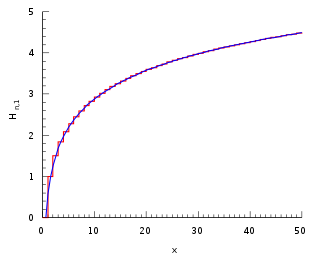Number  | Irrationality measure  | Simple continued fraction  | Notes |
|---|
| Lower bound | Upper bound |
|---|
Rational number  where where  and and  | 1 | Finite continued fraction. | Every rational number  has an irrationality measure of exactly 1. has an irrationality measure of exactly 1. Examples include 1, 2 and 0.5 |
Irrational algebraic number  | 2 | Infinite continued fraction. Periodic if quadratic irrational. | By the Thue–Siegel–Roth theorem the irrationality measure of any irrational algebraic number is exactly 2. Examples include square roots like  and and  and the golden ratio and the golden ratio  . . |
 | 2 | Infinite continued fraction. | If the elements  of the continued fraction expansion of an irrational number of the continued fraction expansion of an irrational number  satisfy satisfy  for positive for positive  and and  , the irrationality measure , the irrationality measure  . . Examples include  or or  where the continued fractions behave predictably: where the continued fractions behave predictably:  and and 
|
 | 2 |
 | 2 |
 [6] [7] [6] [7] | 2 | 2.49846... | Infinite continued fraction. |  , ,  is a is a  -harmonic series. -harmonic series. |
 [6] [8] [6] [8] | 2 | 2.93832... |  , ,  is a is a  -logarithm. -logarithm. |
 [6] [8] [6] [8] | 2 | 3.76338... |  , ,  |
 [6] [9] [6] [9] | 2 | 3.57455... |  | |
 [6] [10] [6] [10] | 2 | 5.11620... |  | |
 [6] [6] | 2 | 5.51389... |  | |
 and and  [6] [11] [6] [11] | 2 | 5.09541... |  and and 
|  and and  are linearly dependent over are linearly dependent over  . . |
 [6] [12] [6] [12] | 2 | 7.10320... |  | It has been proven that if the Flint Hills series  (where n is in radians) converges, then (where n is in radians) converges, then  's irrationality measure is at most 2.5; [13] [14] and that if it diverges, the irrationality measure is at least 2.5. [15] 's irrationality measure is at most 2.5; [13] [14] and that if it diverges, the irrationality measure is at least 2.5. [15] |
 [16] [16] | 2 | 6.09675... |  | Of the form  |
 [17] [17] | 2 | 4.788... |  |
 [17] [17] | 2 | 6.24... |  |
 [17] [17] | 2 | 4.076... |  |
 [17] [17] | 2 | 4.595... |  |
 [17] [17] | 2 | 5.793... |  | Of the form  |
 [17] [17] | 2 | 3.673... |  |
 [17] [17] | 2 | 3.068... |  |
 [18] [19] [18] [19] | 2 | 4.60105... |  | Of the form  |
 [19] [19] | 2 | 3.94704... |  |
 [19] [19] | 2 | 3.76069... |  |
 [19] [19] | 2 | 3.66666... |  |
 [19] [19] | 2 | 3.60809... |  |
 [19] [19] | 2 | 3.56730... |  |
 [19] [19] | 2 | 6.64610... |  | Of the form  |
 [19] [19] | 2 | 5.82337... |  |
 [19] [19] | 2 | 3.51433... |  |
 [19] [19] | 2 | 5.45248... |  |
 [19] [19] | 2 | 3.47834... |  |
 [19] [19] | 2 | 5.23162... |  |
 [19] [19] | 2 | 3.45356... |  |
 [19] [19] | 2 | 5.08120... |  |
 [19] [19] | 2 | 3.43506... |  |
 [17] [17] | 2 | 4.5586... |  and and  | |
 [17] [17] | 2 | 6.1382... |  and and  | |
 [17] [17] | 2 | 59.976... |  | |
 [20] [20] | 2 | 4 | Infinite continued fraction. |  where where  is the is the  -th term of the Thue–Morse sequence. -th term of the Thue–Morse sequence. |
Champernowne constants  in base in base  [21] [21] |  | Infinite continued fraction. | Examples include  |
Liouville numbers  |  | Infinite continued fraction, not behaving predictable. | The Liouville numbers are precisely those numbers having infinite irrationality measure. [5] : 248 |










































































































































































































































